 Did you think, as I did, that the TFX/F-111 was Secretary of Defense Robert McNamara’s only joint-service aircraft project? No, there were two others: the F-4 Phantom II and the A-7 Corsair II, US Navy fighters more or less forced upon, but eventually enthusiastically adopted by, the US Air Force.
Did you think, as I did, that the TFX/F-111 was Secretary of Defense Robert McNamara’s only joint-service aircraft project? No, there were two others: the F-4 Phantom II and the A-7 Corsair II, US Navy fighters more or less forced upon, but eventually enthusiastically adopted by, the US Air Force.
I volunteer as a walking tour docent at Tucson’s Pima Air & Space Museum, where I tell visitors about the USAF F-4E we have on display inside the main hangar. Visitors who take our outdoor tram tour get to see two earlier Vietnam-era models, a Navy F-4J and an Air Force F-4C. I came into the USAF when the F-4 was king, and though I never had to opportunity to fly it I’ve always been interested in the Phantom II, especially the differences between early and late models of the aircraft.
The original McDonnell Aircraft concept for the fighter that eventually became the F-4 was a radical one. The F3H-G Super Demon, as it was then called, was to be a modular attack fighter: depending on mission requirements it would be fitted with a single- or two-seat cockpit, as well as a variety of interchangeable nose sections housing radar, cameras, cannon, or rockets. You can see many of the design features that eventually found their way into the F-4 Phantom II in the 1954 mockup, below.
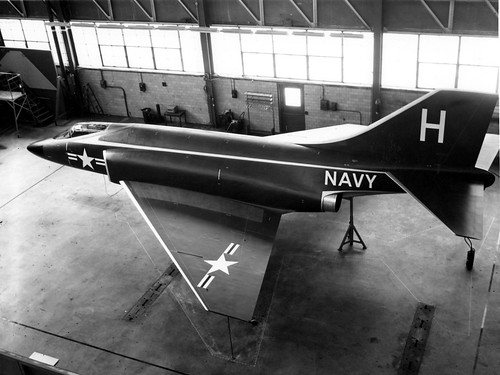
The Navy decided to develop the proposed aircraft as an all-weather fleet defense interceptor, settled on a two-seat configuration, and gave McDonnell Aircraft the go-ahead in 1955. During development, engineers added the three visible features most people associate with the F-4 today: the upward-angled outer wing sections, the downward-angled horizontal stabilizers, and the complex inlet ramps. Wind tunnel testing had shown the need for wing dihedral, but since the central fuselage and wing box had already been designed, it was easier to tip up the outer wing sections to achieve dihedral than to scrap the tooling for the central section of the aircraft (the outer wing sections also got their distinctive “dogtooth” at this time). Wind tunnel tests showed that the original flat horizontal stabilizers would be ineffective at high angles of attack due to turbulent airflow coming off the wings, so they were canted downward. To control airflow to the engines at varying altitudes, airspeeds, and angles of attack, movable inlet ramps were added to the engine intakes.
At some point in the development process the aircraft was formally designated the F4H-1. The Navy toyed with the names Satan (can you imagine anyone even suggesting a name like that today?) and Mithras, but eventually settled on Phantom II, after the original McDonnell FH-1 Phantom. The first prototype flew on 27 May 1958; the Navy began testing the aircraft in 1959.

As shown in the above photo, the earliest F-4s had small radomes, a somewhat different engine inlet design, and a rear cockpit with limited visibility (the seat was on the same level as the one in the forward cockpit, buried down between the engine inlets, with a flat canopy overhead). There were of course many less visible differences as well. Although the Navy initially saw the new aircraft as a fleet defense interceptor, as delivered the F-4 incorporated a robust air-to-ground capability. The Navy began flying the F4H-1 operationally in December 1960, and by 1962 was flying the more recognizable (to today’s eyes) F-4B with its larger radome, redesigned inlets, and raised rear cockpit, which were also characteristic of the USAF’s first version of the Phantom II, the F-4C shown below.
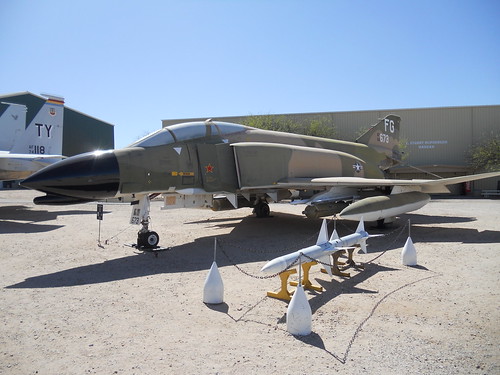
In 1962 Robert McNamara directed the USAF to adopt the F-4. Initially the USAF thought of the new jet as a continuation of the Century series and for a short time called it the F-110 Spectre. Since McNamara (what, him again?) had ordered the services to unify their aircraft designations, the USAF’s F-110 Spectre became the F-4C Phantom II. Unlike the Navy, the USAF from the first planned to employ the new aircraft as a fighter/bomber, flying air-to-air and air-to-ground missions. The USAF began flying the F-4 operationally in 1964.
Our Vietnam-era USAF F-4C, like the Navy F-4B version, has the radome/inlet/cockpit & canopy configuration we’re familiar with today. Like the naval versions, it could carry an air-to-air load of four medium range AIM-7 radar-guided missiles and four short range AIM-9 heat-seeking missiles, plus external fuel tanks. In the air-to-ground configuration it could carry up to 18,000 pounds of a wide variety of ordnance, or a mixed load with AIM-9s for self-defense. Neither the Air Force nor Navy (including Marine Corps) versions had internal guns or cannon.
The most significant difference between the services’ Phantom IIs is not visible from the outside. Navy F-4s did not have flight controls in the rear cockpit, which was occupied by a RIO (radar intercept officer) whose primary flight duty was to operate the fire control system and radar missiles. The Air Force versions have always had duplicate flight controls in the rear cockpit, and for the first few years the USAF assigned rated pilots to both seats (though, as with the Navy, the rear-seater’s primary function was to operate the FCS and radar missiles).

During the 1950s the US military built and deployed a number of fighter and interceptor aircraft that did not incorporate guns or cannon: the thinking of the time was that with the advent of radar- and infrared-guided air-to-air missiles turning dogfights were a thing of the past. In actuality, however, early missiles (especially the longer-range radar-guided missiles) were extremely unreliable, and by the time aircrews visually identified their foe they were almost always too close to fire radar missiles and consequently had to maneuver behind the enemy in order to fire heat-seekers. In other words, to down an enemy aircraft in actual combat, F-4 aircrews had to engage in turning dogfights after all, where the lack of a gun put them at a real disadvantage.
One solution was to carry a podded gun, at least on USAF and, later, USMC F-4s. Initially, 20mm M61 Vulcan Gatling cannons were carried on the centerline station in an SUU-16 pod. USAF F-4s did not have lead computing gunsights in the cockpit, however, and this weapon was inaccurate. Later, with M61s mounted in SUU-23 pods like the one in the photo above, lead computing gunsights were added and the gun became more lethal. In the later years of the Vietnam conflict, with the introduction of the USAF’s F-4E model, the Phantom II finally had an internally-mounted M61, firing through a housing mounted below the radome. The USAF was the only operator of the F-4E: USMC F-4s continued to use podded guns, sometimes mounting two SUU-16s for strafing ground targets; I can find no evidence the Navy ever used gun pods on its F-4s.
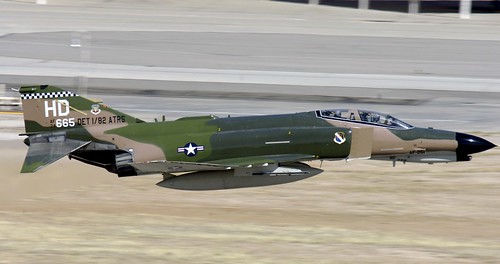
You can see the modified radome and M61 cannon barrel housing on the beautifully-restored USAF F-4E in the above photo. Later USAF F-4Es benefitted from some F-15 Eagle design features, mostly in the fire control system and cockpit avionics, but one visible F-15 feature adapted to the F-4E was the external aft-pivoting centerline fuel tank, designed to separate cleanly and safely when jettisoned.
The Navy had replaced all of its F-4Ns with F-14 Tomcats by 1984, and replaced the last of its F-4S models with F/A-18s in 1986. The USMC retired the last of its Phantom IIs in 1992, when they completed the transition to the F/A-18 Hornet.
When I started flying the F-15 Eagle in 1978, it was replacing the last of the active Air Force F-4Es at operating units in the USA, Europe, and Japan. F-4Es continued to fly in the Air National Guard until 1990. A SEAD (suppression of enemy air defenses) version of the Phantom II, the F-4G Wild Weasel, flew combat missions for the USAF in Desert Storm in the early 1990s, and did not retire until 1996.
No, I haven’t forgotten the tactical reconnaissance versions of the F-4, the RF-4B operated by the USMC and the RF-4C & E models operated by the USAF. Here’s a nice-looking RF-4C, showing some details of its camera nose.
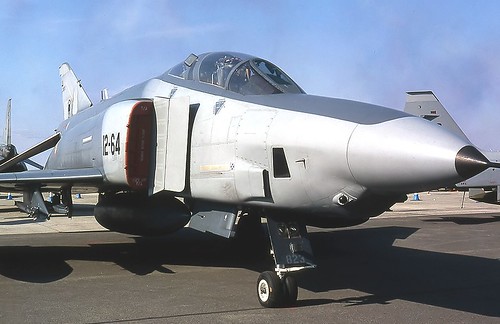
Over the years several allied nation air forces operated export versions of the F-4: Australia, Egypt, Germany, Greece, Iran (oops), Israel, Japan, South Korea, Spain, Turkey, and the United Kingdom. To my knowledge, Egypt, Greece, Iran, Japan, South Korea, and Turkey are still flying their F-4s.
The Boneyard, more properly known as the 309th Aerospace Maintenance and Regeneration Group, is located adjacent to Davis-Monthan AFB in Tucson, right across the street from the Pima Air & Space Museum. It contains acres and acres of F-4s. Occasionally one will be taken out of long-term storage, refurbished, test flown, and ferried to an allied nation to replace an F-4 lost to attrition. This explains the single F-4s we still sometimes see flying over Tucson, always a magnificent sight.
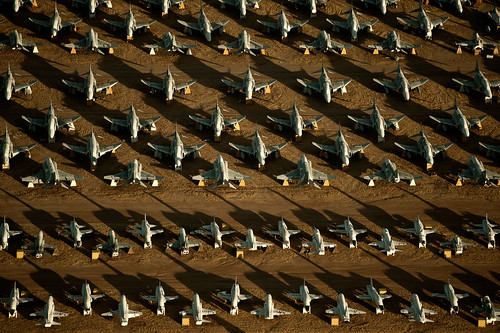
Other long-term storage F-4Es are being converted into remotely-piloted target drones. QF-4Es fly out of two operating locations, Tyndall AFB in Florida and Holloman AFB in New Mexico. When they fly as targets, of course, they are unmanned, as in the photo below. Six QF-4Es have been repainted in camouflage schemes from the F-4’s operational service, four at Tyndall and two at Holloman, to support airshows and USAF-organized heritage flights. These QF-4Es, of course, are flown manned. It cheers me up to know there are still a few F-4 aircrews earning a living flying this famous fighter.
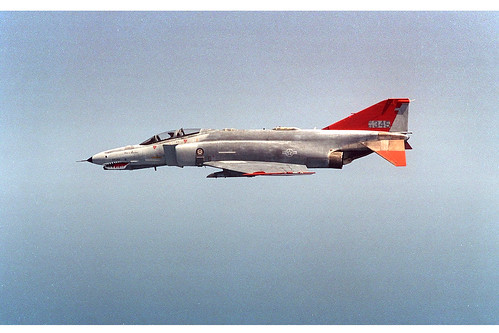
Update (9/24/13): The last QF-4 drone conversion was completed earlier this year. The Boneyard is currently converting older F-16 into QF-16 drones; the first one flew at Tyndall AFB in Florida last week.
References: